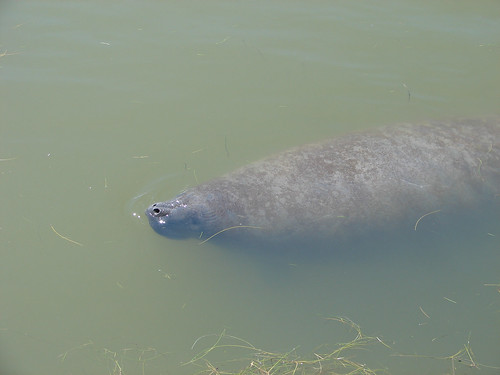 |
| Manatees at Sea World in Orlando, 2005 |
One of my favorite mammals on the planet is the manatee. Some of my best photos are of captive manatees at Sea World, but there are places where they’re pretty easy to see in the wild, too. I love watching these gentle giants, looking rather like swimming, oversized potatoes, even as seeing them virtually always breaks my heart. Just about every manatee I’ve ever had a good look at bore scars on its back from motorboats.
 |
| Manatee munching on algal slime on the breakwall at the Visitor Center at Flamingo in Everglades National Park in 2018. |
This winter has seen a major die-off of manatees, especially in the Indian River Lagoon where they seek warmer waters during cold spells. Many of the necropsies showed the animals were badly emaciated, almost certainly caused by the dearth of seagrass in the lagoon, due to runoff of agricultural and lawn chemicals. (See National Geographic news here.)
Florida’s sugar trade has exacted a shockingly heavy toll on the Everglades. Agriculture in general along with development for both the tourist trade and the housing explosion for retirees have wiped out a great deal of the natural beauty that makes Florida unique. I’ve usually driven to Florida, but have flown often enough to have noticed how, every trip, even more of the landscape has been scarred with highways and housing and farmland. From a jet, it’s impossible to look down on what should be vast, untrammeled Everglades or vast scrubland without seeing roads and housing and irrigation patterns.
Despite its wealth of species unique in America, Florida has squandered much of its natural heritage as if it were infinite. They’ve not only damaged the vast majority of the fragile coastline and inland scrub habitat to development and pollution. They’ve also allowed the introduction of incredible numbers of invasive plants and animals that have exacted their own toll on Florida's unique native wildlife. A lot of news attention has been focused on two of those invasive non-native species.
In recent years when cold nights are predicted, areas of the state actually issue warnings about falling green iguanas. Huge, beautiful, plant eating iguanas, native to Central and South America, Mexico, and a few islands in the Caribbean, have escaped to the wilds of Florida via the pet trade. Resort owners have been distressed about iguanas because they feed voraciously on expensive ornamental plants and then, during cold snaps when their cold-blooded bodies can’t function, they drop out of trees, putting any tourists below at risk. Ecologists are more focused on the already-endangered plants and tree snails the iguanas consume.
The other invasive species getting media attention is the Burmese python, another escapee from the pet trade. Pythons have decimated muskrats, raccoons, and swamp rabbits in the Everglades—one study showed that 77 percent of the swamp rabbits released with radio transmitters into the Everglades were killed by pythons.
These snakes also take out a huge number of wading bird eggs and nestlings every year now. In 2019, I got my first videos of adorable nestling Anhingas studying the world around them. I can’t watch them without shuddering to realize how many baby Anhingas and other colonial nesters see as their last glimpse of the world the huge maw of a python closing in.
The first recorded python in the Everglades was caught near Everglades Safari Park on the Tamiani Trail in October 1979. More and more were being seen and reported in the park in the 1990s, but the Florida state Fish and Wildlife Conservation Commission insisted they weren’t an ecological threat until 2000, when their first acknowledgement of the threat came with their admission that the python population was entirely out of control.
Now, two full decades after that, the Florida state Fish and Wildlife Conservation Commission is FINALLY closing the barn door, after all the animals have escaped. They voted 7 to 0 to ban possession and breeding of both the iguana and the python along with 14 other nonnative species. The ban will be phased in over three years to give businesses time to get rid of their breeding stock; it does not require a roundup of pets, whose owners can keep them for as long as the animals live, just not replace them.
The law clearly cannot do anything about all the pythons already in the Everglades and is obviously something that should have been done decades ago, but it’s a start. It’s sad and frustrating to have spent my entire adult life watching people make starts like this, and then moving on and forgetting all about them, allowing ignorance and selfishness to whittle away at what little progress we make in protecting the environment. I have at the very most 2 or 3 decades remaining in my own lifespan, and can already feel myself slowing down a bit even as I’m feeling ever more desperate to do something about the world I’m bequeathing my children and grandchild.
Ironically, the people of my generation most focused on the inheritance they’re leaving their children and grandchildren seem to understand how monetary capital grows even as they’re perfectly willing to chip away at our natural resource capital. If Florida Scrub-Jays and Wood Storks and Anhingas were assigned a monetary value, the diminished numbers of those living today versus when we were born could possibly open people’s eyes to how much we’ve squandered our own inheritance as well as that of future generations. If ignorance is bliss, we belong to the happiest of species.





